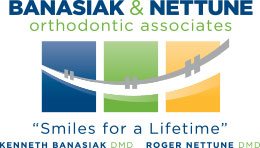True orthodontic emergencies are very rare, but when they do occur we are available to you. As a general rule, you should call the office when you experience severe pain or when you have a painful appliance problem that you can’t take care of yourself. We’ll be able to schedule an appointment with Drs. Roger Nettune and Kenneth Banasiak. You might be surprised to learn that you may be able to temporarily solve many problems yourself until you schedule an appointment with Banasiak & Nettune Orthodontic Associates. The following solutions may help you relieve your discomfort: Poking Wire: Using a pencil eraser, push the poking wire down or place wax on it to alleviate the discomfort. Loose Bracket or Band: […]
Wisdom teeth are a type of molar that is found in the very back of your mouth and are the last molars to develop. There are four wisdom teeth: upper left, upper right, lower left, and lower right. These teeth usually appear in late teens or early twenties but may become impacted (fail to erupt) due to lack of room in the jaw or angle of entry. The removal of wisdom teeth has become so commonplace that it is almost a rite of passage for young adults. Drs. Nettune and Banansiak will tell you that when a tooth is impacted, it may need to be removed. If it is not removed, you may develop gum tenderness, swelling, or even severe […]
Usually patients undergoing orthodontic treatment with Dr. Roger Nettune and Dr. Kenneth Banasiak already have their permanent teeth – they are pre-teens, teens and adults. But in some cases we have to start treatment earlier, even before the patient’s permanent teeth come in. We call this “two-phase treatment.” When we have patients with clear developmental problems at an early age, it’s best to start work when they are young, before the problems get bigger and more difficult to treat. Examples include: • An upper or lower jaw that is not growing correctly• A mouth growing in a way that doesn’t leave enough room for all the permanent teeth to come in• A severe malocclusion, or bad bite, which means the […]
Some people wonder why Drs. Roger Nettune, Kenneth Banasiak and our team work tirelessly to give our patients straight teeth. Of course it’s nice to have a smile full of evenly-aligned teeth, but did you know that straightening your teeth at Banasiak & Nettune Orthodontic Associates can keep them healthier? Straight teeth lead to better oral hygiene, increasing your chances of keeping your own natural teeth for a lifetime! Straight teeth are less prone to decay, because they collect less plaque—the sticky colorless substance that forms on our teeth and leads to tooth decay; and they are easier to keep clean! If you’re wondering whether your teeth might cause problems because they are out of alignment, please give us a […]
“Dentists, Orthodontists, they’re all the same right?” We hear our patients asking this question as they wonder about the difference between an orthodontist and a dentist. Before becoming an orthodontist Drs. Roger Nettune and Kenneth Banasiak started out in dental school and earned a DDS (dental degree), just like your dentist. After dental school however, they decided to learn more about orthodontics, which is one of nine specialties within the dental field. So they stayed in school for a few more years and became experts in orthodontics, which focuses on tooth and jaw alignment and bite problems like overbites and under bites. Other dental specialties you may have heard of include endodontic (focusing on the soft tissue inside your teeth), […]
Everyone loves fun facts. Fun, fun, fun! The American Association of Orthodontists, or AAO, has come up with some fun facts about orthodontics that our team thought you might enjoy today. • There are nearly 4 million people in orthodontic treatment throughout the United States. Three out of four are younger than 18.• The first mechanical treatment for correcting irregular teeth was suggested by Gaius Plinius Secundus (A.D 23-79).• The American Association of Orthodontists is comprised of more than 12,000 members in the United States, Canada and abroad.• The time required to complete orthodontic treatment ranges from 12 to 36 months depending on the nature and severity of the problem.• Of the 160,000 dentists in the United States and Canada, […]




 Basking Ridge
Basking Ridge
